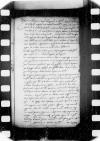List #1610
Mikołaj GRABIA do Ioannes DANTISCUSCracow (Kraków), 1537-03-29
| odebrano [1537]-04-07 Rękopiśmienne podstawy źródłowe:
Pomocnicze podstawy źródłowe:
| ||||||
Tekst + aparat krytyczny + komentarz Zwykły tekst Tekst + komentarz Tekst + aparat krytyczny
Reverendissimo in Christo Patri Domino
Reverendissime in Christo Pater et Domine, domine gratiosissime et colendissime.
Post sui et servitutis meae propensae in gratiam eius consuetam commendationem.
Cum mihi is servitor Reverendissimae Dominationis Vestrae commode se ob ms. p(!)
⌈bb ms. p(!)
⌉tulerit, nolui committere, quin inviserem litteris meis Reverendissimam Paternitatem Vestram, cui omnia felicia et fausta precor ac deinde scriberem ea, quae
Nuntii
De
Ex
De officiis aulae distributis non scribo Reverendissimae Dominationi Vestrae, quoniam compertum iam habet, quorsum cesserint. Mihi vero etiam cessit iam carissima
Commendo me tandem gratiae solitae Reverendissimae Dominationis Vestrae. Quam Dominus Deus diutissime servet incolumem.
Reverendissimae Paternitatis Vestrae servitor humil(limus) or humil(is)⌈humil(limus)humil(limus) or humil(is)⌉


 AAWO, AB, D. 4, f. 105v
AAWO, AB, D. 4, f. 105v